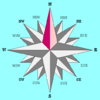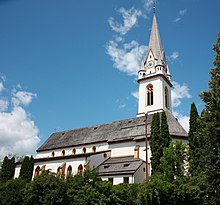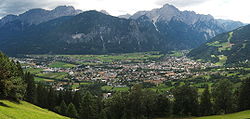Lienz
Lienz
Lianz | ||
|---|---|---|
|
From top down, left to right: Main Square, City Hall (former Schloss Liebburg), Lienz as seen from the North, Burg Bruck, Iselsteg bridge and Iselturm | ||
|
Postal code 9900 | ||
| Area code | 04852 | |
| Vehicle registration | LZ | |
| Website | www.stadt-lienz.at | |
Lienz (German:
Geography
Lienz is located at the
By the consistent growth of the city, some smaller villages around – though officially municipalities in their own right – are now widely considered to be suburbs of Lienz. Those suburbs comprise:
| Thurn, Gaimberg | ||
| Leisach, Oberlienz | 
|
Nußdorf-Debant |
| Amlach, Tristach |
History
The area of Lienz had been settled since the

Lienz itself was first mentioned as Luenzina in a deed issued by the
Located on the important trade route from Venzone in Friuli to Salzburg, the market town of Lienz received city rights on 25 February 1242. In 1278 the Counts finished Burg Bruck, a castle that until 1500 served as their local seat. When the Meinhardiner became extinct in 1500 upon the death of Count Leonhard of Gorizia, their estates were bequeathed to the Habsburg King Maximilian I and finally incorporated into the County of Tyrol. From the status of an Imperial residence, Lienz sank to the insignificance of a provincial town within the Habsburg monarchy.

During the Italian campaigns of the French Revolutionary Wars, Lienz was occupied twice by French troops in 1797. After the Austrian defeat at the Battle of Austerlitz, Lienz with Tyrol passed to the newly elevated Kingdom of Bavaria according to the 1805 Peace of Pressburg. In 1809 it became the administrative centre of a district within the short-lived Napoleonic Illyrian Provinces, but was reconquered by Austrian troops in 1813. Within the Austrian Empire (the Cisleithanian part of Austria-Hungary after 1867) it was the seat of the district of the same name, one of the 21 Bezirkshauptmannschaften in Tyrol.[3]
In November 1918 it was occupied by the Italian Army.
On
Climate
Lienz has relatively warm and humid summers and cold winters. 1971–2000 there was a recorded precipitation of 915 mm (36 in). Most of the rain falls during the summer months, especially from June to August (respectively 98, 119 and 100 mm (3.9, 4.7 and 3.9 in)). The driest months are January and February (42 and 35 mm (1.7 and 1.4 in))
The average temperature in July is 7.0 °C (44.6 °F). In January it is about 17.9 °C (64.2 °F) −5.2 °C (22.6 °F). Lienz is also one of the sunniest cities in Austria with an average of 5.4 hours of sun per day or 1952 hours per year. The
| Lienz | ||||||||||||||||||||||||||||||||||||||||||||||||||||||||||||
|---|---|---|---|---|---|---|---|---|---|---|---|---|---|---|---|---|---|---|---|---|---|---|---|---|---|---|---|---|---|---|---|---|---|---|---|---|---|---|---|---|---|---|---|---|---|---|---|---|---|---|---|---|---|---|---|---|---|---|---|---|
| Climate chart (explanation) | ||||||||||||||||||||||||||||||||||||||||||||||||||||||||||||
| ||||||||||||||||||||||||||||||||||||||||||||||||||||||||||||
| ||||||||||||||||||||||||||||||||||||||||||||||||||||||||||||
| Climate data for Lienz (1971–2000) | |||||||||||||
|---|---|---|---|---|---|---|---|---|---|---|---|---|---|
| Month | Jan | Feb | Mar | Apr | May | Jun | Jul | Aug | Sep | Oct | Nov | Dec | Year |
| Record high °C (°F) | 12.9 (55.2) |
21.0 (69.8) |
24.0 (75.2) |
25.9 (78.6) |
30.0 (86.0) |
33.0 (91.4) |
37.7 (99.9) |
33.7 (92.7) |
30.0 (86.0) |
26.0 (78.8) |
17.2 (63.0) |
15.5 (59.9) |
37.7 (99.9) |
| Mean daily maximum °C (°F) | 0.1 (32.2) |
4.7 (40.5) |
10.1 (50.2) |
14.4 (57.9) |
19.3 (66.7) |
22.5 (72.5) |
24.9 (76.8) |
24.4 (75.9) |
20.5 (68.9) |
14.2 (57.6) |
5.7 (42.3) |
0.2 (32.4) |
13.4 (56.1) |
| Daily mean °C (°F) | −5.2 (22.6) |
−1.9 (28.6) |
3.1 (37.6) |
7.6 (45.7) |
12.7 (54.9) |
15.9 (60.6) |
17.9 (64.2) |
17.2 (63.0) |
13.0 (55.4) |
7.3 (45.1) |
0.6 (33.1) |
−4.2 (24.4) |
7.0 (44.6) |
| Mean daily minimum °C (°F) | −9.0 (15.8) |
−6.3 (20.7) |
−1.6 (29.1) |
2.1 (35.8) |
6.7 (44.1) |
9.9 (49.8) |
11.8 (53.2) |
11.5 (52.7) |
7.8 (46.0) |
3.0 (37.4) |
−2.7 (27.1) |
−7.3 (18.9) |
2.2 (36.0) |
| Record low °C (°F) | −24.7 (−12.5) |
−24.5 (−12.1) |
−15.6 (3.9) |
−5.7 (21.7) |
−7.4 (18.7) |
1.3 (34.3) |
3.1 (37.6) |
1.8 (35.2) |
−2.2 (28.0) |
−11.6 (11.1) |
−18.8 (−1.8) |
−21.1 (−6.0) |
−24.7 (−12.5) |
| Average precipitation mm (inches) | 42.4 (1.67) |
35.0 (1.38) |
58.6 (2.31) |
65.6 (2.58) |
85.4 (3.36) |
97.8 (3.85) |
119.0 (4.69) |
99.9 (3.93) |
88.5 (3.48) |
96.3 (3.79) |
76.5 (3.01) |
50.1 (1.97) |
915.1 (36.03) |
| Average snowfall cm (inches) | 31.1 (12.2) |
21.6 (8.5) |
21.7 (8.5) |
5.7 (2.2) |
1.0 (0.4) |
0.0 (0.0) |
0.0 (0.0) |
0.0 (0.0) |
0.0 (0.0) |
1.4 (0.6) |
18.1 (7.1) |
29.1 (11.5) |
129.7 (51.1) |
| Average precipitation days (≥ 1.0 mm) | 5.4 | 4.2 | 5.7 | 7.4 | 10.6 | 11.8 | 11.2 | 11.2 | 7.9 | 7.3 | 6.4 | 5.9 | 95.0 |
| Average relative humidity (%) (at 14:00)
|
74.1 | 55.4 | 48.6 | 46.8 | 50.5 | 51.7 | 51.0 | 52.7 | 54.4 | 57.8 | 69.7 | 79.9 | 57.7 |
| Mean monthly sunshine hours | 76.1 | 151.2 | 175.4 | 175.8 | 200.2 | 205.6 | 237.5 | 227.7 | 194.1 | 164.6 | 97.0 | 46.2 | 1,952 |
| Percent possible sunshine | 41.7 | 57.5 | 55.3 | 49.9 | 48.6 | 49.8 | 56.4 | 58.5 | 60.2 | 54.4 | 45.5 | 30.0 | 50.7 |
| Source: Central Institute for Meteorology and Geodynamics[6]
| |||||||||||||
Population
| Year | Pop. | ±% |
|---|---|---|
| 1869 | 2,484 | — |
| 1880 | 3,142 | +26.5% |
| 1890 | 3,878 | +23.4% |
| 1900 | 4,549 | +17.3% |
| 1910 | 6,532 | +43.6% |
| 1923 | 6,591 | +0.9% |
| 1934 | 6,885 | +4.5% |
| 1939 | 8,458 | +22.8% |
| 1951 | 10,096 | +19.4% |
| 1961 | 11,132 | +10.3% |
| 1971 | 11,741 | +5.5% |
| 1981 | 11,661 | −0.7% |
| 1991 | 11,864 | +1.7% |
| 2001 | 12,079 | +1.8% |
| 2011 | 11,955 | −1.0% |
Politics
Seats in the municipal assembly (Gemeinderat) as of 2010[update] elections:
- Austrian People's Party (ÖVP): 11
- Social Democratic Party of Austria (SPÖ): 7
- Town of Lienz Party (LSL): 2
- Freedom Party of Austria (FPÖ): 1
Transport
Lienz is located at a road junction between the Drautalstraße highway, leading from
Notable people

- count of Gorizia.
- Albert Anton von Muchar (1786-1849), an Austrian historian.[8]
- Beda Weber (1798-1859), author, theologian and member of the Frankfurt Parliament.[9]
- Albin Egger-Lienz (1868-1926), painter of rustic genre and historical paintings.
- Theodor Danegger (1891–1959), film actor, he appeared in over 70 films between 1932 and 1959.
- Raimund Abraham (1933-2010), architect, self-described as an incurable formalist
Sport
- Josef "Pepi" Stiegler (born 1937), gold medallist in Alpine skiing at the 1964 Winter Olympics
- Anton Steiner (born 1958), an Austrian former alpine skier and bronze medallist at the 1984 Winter Olympics
- Alexander Lugger (born 1968), Austrian ski mountaineer and coach of the national team.
- Fritz Strobl (born 1972), World Cup skier, gold medallist at the Alpine skiing at the 2002 Winter Olympics, and winner of nine World Cups.
- Wolfgang Mair (born 1980), an Austrian footballer, played over 440 games.
- Dominic Hassler (born 1981), former football striker, played over 310 games.
International relations
Twin towns – Sister cities
Lienz is
 Gorizia, Italy, since 2000
Gorizia, Italy, since 2000 Jackson, Wyoming, United States, since 1970
Jackson, Wyoming, United States, since 1970 Selçuk, Turkey, since 1970
Selçuk, Turkey, since 1970
See also
- The Betrayal of Cossacks
- Dolomitenmann
References
- ^ "Dauersiedlungsraum der Gemeinden Politischen Bezirke und Bundesländer - Gebietsstand 1.1.2018". Statistics Austria. Retrieved 10 March 2019.
- ^ "Einwohnerzahl 1.1.2018 nach Gemeinden mit Status, Gebietsstand 1.1.2018". Statistics Austria. Retrieved 9 March 2019.
- ^ Klein, Wilhelm (1967). Die postalischen Abstempelungen auf den österreichischen Postwertzeichen-Ausgaben 1867, 1883 und 1890.
- ^ "Archived copy" (PDF). Archived from the original (PDF) on 22 August 2017. Retrieved 23 August 2017.
{{cite web}}: CS1 maint: archived copy as title (link) - ^ Climate Summary for Lienz
- ^ "Klimadaten von Österreich 1971–2000 – Tirol-Lienz" (in German). Central Institute for Meteorology and Geodynamics. Archived from the original on 12 October 2019. Retrieved 25 October 2019.
- ^ Susannah Osborne (2 November 2012). "East Tirol – Austria's secret ski destination". The Guardian. Retrieved 28 December 2017.
- ^ Schlager, Patricius (1911). . Catholic Encyclopedia. Vol. 10.
- ^ Scheid, Nikolaus (1912). . Catholic Encyclopedia. Vol. 15.
External links
![]() Media related to Lienz at Wikimedia Commons
Media related to Lienz at Wikimedia Commons





